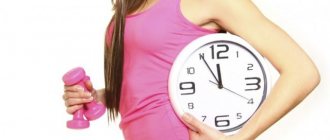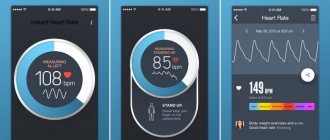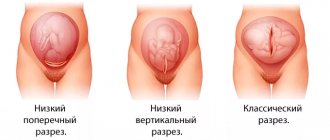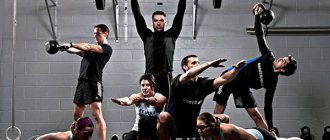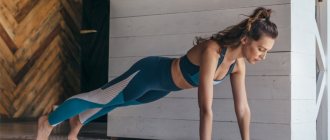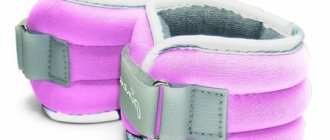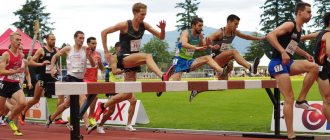What is the best strength training for weight loss? What types are there and what to choose? How do both types affect weight loss while dieting?
Author: Lyle McDonald, bodyrecomposition.com Translation:
Although many are still only interested in the number on the scale, the main goal of the diet is not weight loss, but fat loss, while maintaining muscle.
For decades, the idea that you need to change up your workouts while losing weight has been popular. You need to exercise more often, lower the working weights, increase the repetitions, and reduce the rest between sets. Such training is called “relief” training, as opposed to “mass” training.
This is how those who used anabolic steroids “dried” in the 70-80s, and this is a completely different physiological state of the body. For the average person, their techniques are a recipe for failure.
Metabolic versus heavy strength training
All strength training can be divided into two categories: metabolic and heavy strength. Metabolic involves a high number of repetitions (for example, 4 sets of 15 repetitions), light working weight, short rest between sets (30-60 seconds or less). “Heavy” training - fewer repetitions (6-12), more weight, longer rest between sets (1.5-3 minutes).
Each of these types has its pros and cons for losing weight and maintaining muscle while dieting.
Metabolic training burns more calories, depletes glycogen, and has a hormonal response very similar to interval training, which helps with weight loss. And the lighter loads used here place less stress on the joints.
But there are also disadvantages. The main stimulus for muscle growth is their high tension during work (heavy weights). That is, you need to work out quite hard and add weight to the bar over time. All those stimuli that help grow muscles will protect them during a diet. It's easy to guess what happens to the muscles when you reduce the weight on the bar and move to relief. You remove one of the main stimuli for maintaining muscles - high muscle tension - and the muscles become smaller. The body no longer has a reason to maintain muscles that are not used as much as before.
This is the main disadvantage of metabolic training - weight loss. But there is one exception - beginners, who don't have to worry about losing muscle because they haven't trained before. Almost any strength training will support the muscles they have. But for people with experience in strength training, switching to “light” high-repetition sets to lose weight is a recipe for disaster.
The advantages of “heavy” strength training are precisely that they better support muscles on a diet, and this is one of the main goals. Well, the disadvantages are the opposite of what is listed for metabolic training: modest calorie consumption, little glycogen depletion and no hormonal response.
But if you remember the main goal of the diet (lose fat/maintain muscle), none of this matters. And if you have to choose only one type of strength training on a diet, let it be “heavy” strength training to protect the muscles, and let the calorie deficit (and cardio optional) take care of the fat loss.
But this is if there is a need to choose. There is no good reason why both types of strength cannot be combined during a diet. This can provide pros while eliminating the cons of each approach.
Experiment by British scientists
Scientists from the universities of Bath and Birmingham in the UK conducted a study to find out the optimal time for training. Experts organized an experiment in which 30 overweight men took part.
Photo: istockphoto.com
The participants were divided into three groups. It was assumed that the first would train before breakfast, the second - immediately after, and the third - adhere to their standard daily routine.
The experiment lasted six weeks and showed that the regime of the first group of volunteers was the most effective. They burned calories twice as fast as other participants.
In addition, scientists have found that exercising before meals improves the body's sensitivity to insulin. This, in turn, reduces the risk of developing diabetes.
You can find out which foods help speed up your metabolism and burn more calories from the “Championship” video.
How to combine training?
First, what not to do. Increasing the number of workouts and their duration while on a diet is a failed strategy. Recovery during an energy deficit is poorer, and trying to do more and more work explains why so many people end up in a state of severe overtraining and exhaustion. In general, too much training and too few calories is bad.
Hard training
The amount of training required to maintain muscles is much less than what is needed to grow them: it is enough to leave only a third of what you did before. But it is fundamentally important that the working weights remain the same. For example, to grow muscles, you worked out twice a week and at each workout you did 6 sets of 6-8 repetitions per muscle group. While losing weight, you can leave only 2 heavy sets of 6-8 repetitions while maintaining working weights and exercise once a week. Yes, just two heavy approaches.
If you train a muscle group once a week, you can simply reduce the number of approaches. If during training you did a total of 20-24 approaches per muscle group, 6-8 approaches on a diet will be enough. Instead of a 1.5-hour workout, you can do it in 30-40 minutes, depending on the warm-up and rest between sets. But, again, the weights should remain the same.
Metabolic training
As mentioned above, these workouts usually include everything high-repetition and with a short rest period. But it is important to remember that when you are on a diet, due to fatigue and lack of energy, exercise technique often suffers and injury can occur. Therefore, only people with very good technique can do “difficult”, complex movements quickly but safely. For others, exercise machines may be safer. The key is to keep rest intervals short.
Although the duration of the workouts will be short (20-40 minutes), they can be very tiring, which is expected. Metabolic training parameters:
- 2-4 approaches
- 15-20 reps
- 5-7 exercises
- Short rest intervals (60 seconds or less).
Should you exercise on an empty stomach?
For more effective weight loss, do not rush with your morning meal. The maximum amount of fat is burned during exercise on an empty stomach. Basically, the body draws energy from carbohydrates, and when there is not enough of them, it switches to using fat tissue as a backup source.
How to deceive hunger? 5 simple but effective ways
True, there are some nuances here. If you are in poor health or have heart problems, it is better to limit yourself to a light workout in the morning and not overload yourself. Since the blood is thicker at first after waking up, it is not so easy to push it through the vessels, which becomes an additional burden on the heart.
Weekly planning
Now you can plan your workouts for the week. Basically, you can do both types of workouts on the same day or on different days. Considering that most people try to exercise too much on a diet, when in doubt, please err on the side of “less.” It will pay off in the long run.
Much will depend on what the “heavy” strength looks like. Some people like two or three hard, short workouts for the whole body. But if it takes a lot of time, you are unlikely to be happy after such a workout to also do a metabolic one. In this case, it is better to postpone it to a separate day. Another option is to divide your workouts into upper-lower classes, and then strength training can be combined with metabolic training in one session.
Examples are in the table below. T - heavy training, M - metabolic. For no particular reason, we will assume that there are no training sessions on the weekend.
- Options 1 and 2 are for those who have time to recover from four workouts a week, and those who love full-body workouts.
- Option 3 is for those who need more days to recover.
- Option 4 is simply one of a million different ways to use traditional bodybuilding split training. One of the problems here is that metabolic training is usually full-body, so it does not always combine well with dividing heavy training into muscle groups. If metabolic training on Monday makes you too tired to do a heavy leg workout on Wednesday, it won't be the best option.
The table doesn't show every option, but it does show the limit of how much high-intensity work you can do in a calorie deficit. Many people, in an effort to get quick results, try to do too many things without paying attention to the overall workload or the interaction of different components in the program, and pay the price down the road.
Menu: meal plan
Regardless of the goal of training (weight loss or weight gain), you will need to switch to proper nutrition, which performs several functions:
- normalization of metabolism;
- normalization of sugar and cholesterol;
- elimination of fat layer;
- muscle strengthening;
- creating a beautiful relief on the body;
- increasing endurance and physical strength.
It is impossible to eat only hamburgers and have a beautiful figure. However, proper nutrition does not mean giving up delicious foods. There are a huge number of recipes for preparing delicious and healthy food. For example, you can make your favorite hamburger yourself using homemade tomato paste and mayonnaise, boiled meat, and bran bread.
When creating a menu, use a few useful tips
:
- Eat small meals, 5-6 times a day in small portions. This way, food is digested easier and faster, and enough calories are supplied to eliminate the feeling of hunger for a long time.
- Count the calories you eat
. To lose weight, a woman needs to consume from 1500 to 2000 calories per day, a man – from 1800 to 2300 calories. To gain muscle mass, a woman needs from 2000 to 2200 calories, a man - from 2300 to 2600 calories. - Don't give up fat. A balanced diet involves consuming 50% carbohydrates, 25% proteins and 25% fats. To lose weight, the norm of carbohydrates and fats is reduced - 40% and 15%, respectively.
- For snacks, use low-calorie foods - vegetables, fruits, dairy products.
- Avoid alcohol. Any type of alcoholic beverages negatively affects the process of losing weight and gaining muscle mass. A small amount of dry red wine is allowed.
- Avoid sugar and flour dishes. These products slow down metabolism, which is unacceptable for an active person.
By following these rules, you can create a menu consisting only of healthy foods.
Return to article content
Breakfast
Breakfast gives the body energy for the whole day, so you shouldn’t skip it. The first meal should take place within an hour of waking up so that the body does not trigger the energy-saving mechanism and does not begin to accumulate fat.
For breakfast you need to eat carbohydrates, fiber and proteins. A small amount of whole grain bread is allowed.
Here are some delicious and nutritious breakfast options:
- Buckwheat porridge with milk, toast with cheese, green tea. A glass of milk (second breakfast)
. - Oatmeal in water with dried fruits, coffee. Natural yogurt, apple
(second breakfast). - Baked cottage cheese pancakes with sour cream, fermented baked milk. Banana (second breakfast).
After second breakfast, you can snack on nuts, a piece of cheese, or any vegetable.
Return to article content
Dinner
Lunch should be hearty and nutritious, containing fats and proteins. The main thing is to chew your food thoroughly and take your time. Ideal lunch option - soup, main course
and a drink that should be consumed 30 minutes after eating.
Here are some menu options:
- Mushroom soup with potatoes, pasta with minced meat, tea with toast.
- Broccoli puree soup, chicken breast baked with zucchini, dried fruit compote.
- Fish soup, rice with salmon, vegetable salad, green tea.
- Borscht in vegetable broth, steamed chicken cutlet, mashed potatoes, freshly squeezed juice.
Return to article content
Dinner
Dinner should be light and low in calories. For example, 100 g chicken, salad
from vegetables, tea. This is enough to satiate and eliminate the feeling of hunger until the morning.
Like breakfast, the first meal is taken at approximately 18:00, the second - 2 hours before bedtime. Dinner options:
- Chicken fillet, vinaigrette, black tea. Late dinner - natural yogurt.
- Zucchini stuffed with rabbit meat, compote. Second dinner - kefir.
- Fish casserole, cucumber and tomato salad, berry smoothie. Late dinner - fermented baked milk.
Return to article content
Summing up
Both types of training have both pros and cons. Assuming that muscle maintenance is one of the main goals during a diet, "hard" training should be in the program. If you have to choose only one type, let it be this one. The exception is beginners, for whom any strength training is effective.
The volume and frequency of training should be reduced to a third to avoid overtraining. The fundamental condition is to maintain working weights. From a muscle maintenance standpoint, it's much better to do 2 quality heavy sets than 6 mediocre sets.
Metabolic training can be added to the “heavy” ones. The training program will depend on the individual, their ability to recover, their schedule, and their diet.
A set of exercises for losing weight at home
Taking into account the mechanism of weight loss, you can create a full workout from the simplest exercises for losing weight at home. For convenience, we divide them into 3 groups:
- on the thighs and buttocks;
- abdominal muscles;
- shoulder girdle.
Beginners can train each muscle group on a separate day, and for trained athletes, the presented complex can be one workout, just for the whole body at once.
Day 1 (Monday) – thighs and buttocks
Squats: 3 sets of 15 reps. We stand straight, feet shoulder-width apart, toes pointing slightly to the sides. As you inhale, we squat until the knees are at a right angle and the thighs are parallel to the floor, and as we exhale, we rise.
Pelvic lifts: 2 sets of 10 reps. We lie down on the floor, bend our legs at the knees and rest our feet on the floor, stretch our arms along the body. As you inhale, raise your pelvis so that your body extends into a straight line and hold it for 5-10 seconds. As you exhale, we lower ourselves to the floor.
Plie squats: 2 sets of 10 reps. Performed similarly to regular squats. The difference is in the position of the legs - they need to be placed wide, and the toes should be pointed outward. Your hands can be clasped in front of you or placed on your hips. As you inhale, lower yourself until your thighs are parallel to the floor, stay at the lowest point for a couple of seconds, and as you exhale, rise up.
Leg swings: 2 sets of 20 times on each leg. Can be performed lying down or standing. The principle of execution is the same - as you exhale, raise your leg as high as possible, while inhaling, lower it as slowly as possible. To increase the load, you can use weights or fitness bands.
-15%
Weighting agent 1 kg (pair) For outdoors
PRIME SPORT (RUSSIA)
Weights are a popular sports equipment that, despite its compactness and simplicity, plays a very important role in the training process. Externally, these are cuffs made of a special material...
To favorites
Compare
1 review
5.0
- Efficiency 5.0
- Price quality
5.0 - Design
5.0
460 rub.
390 rub.
Offline
1 PC. at the address: Chekhov, st. Moskovskaya, possession 96, shopping center "Carnival", 3rd floor +7(929)911-48-77 Mon-Sun: from 10:00 to 22:00 2 pcs. at the address: Moscow, st. Starokachalovskaya, building 5a, shopping center "Krug", 1st floor +7 (929) 911-48-98 Mon-Sun: from 10:00 to 22:00
-19%
Fitness set Mini Bands HVAT Outdoor
HVAT (RUSSIA)
To achieve excellent physical shape, you have to train for hours in the gym. But, unfortunately, not everyone has this opportunity. Many people have catastrophic failure...
To favorites
Compare
4 reviews
4.2
- Efficiency 3.5
- Price quality
3.5 - Design
4.8
990 rub.
799 rub.
Offline
3 pcs. at the address: Chekhov, st. Moskovskaya, possession 96, shopping center "Carnival", 3rd floor +7(929)911-48-77 Mon-Sun: from 10:00 to 22:00 4 pcs. at the address: Serpukhov, Borisovskoe highway, building 1, shopping center "Korston", 1st floor +7(929)552-18-69 Mon-Sun: from 10:00 to 22:00 2 pcs. at the address: Moscow, st. Starokachalovskaya, building 5a, shopping center "Krug", 1st floor +7 (929) 911-48-98 Mon-Sun: from 10:00 to 22:00
Day 2 (Wednesday) – abs
Classic sit-ups: 2 sets of 20 reps. Lie on the floor on your back, preferably near the sofa so that you can cling to its lower part with your feet. Clasp your hands at the back of your head. As you exhale, we rise, trying to reach our chest towards our knees; as we inhale, we lower ourselves. In the end, you don’t have to lower yourself all the way to the floor - this way the muscles will be constantly tense.
Oblique crunches: 2 sets of 20 reps. Starting position as in the previous exercise. The technique is the same, only on the way up, stretch your elbow to the opposite knee: left to right, and on the next repetition, right to left.
Side plank: 30 seconds on each side. If it works, you can hold the position longer. Lie on the floor on your side, then lift your body, leaning on your elbow. The whole body should stretch out in a straight line. Hold the position for the specified amount of time.
“Boat”: 2 sets of 10 repetitions. Lie on the floor on your stomach, stretch your arms forward in front of you. As you exhale, lift your arms and legs off the floor and hold the position for 5 breaths. Get down on the floor. On the last rep, you can grab your ankles with your hands and rock a little.
On this topic:
Preparing your abs for summer: the simplest but most effective exercises with and without equipment
Day 3 (Friday) – shoulder girdle and chest
Push-ups: 2 sets of 10 reps. Girls can do push-ups from their knees, since this way the load will be less. Hands should be placed under the upper chest at a distance slightly greater than shoulder width.
Reverse push-ups: 2 sets of 10 reps. Stand with your back to the sofa, lean on its edge with your hands, stretch your legs in front of you. As you inhale, lower yourself, bending your arms to a right angle at the elbows, and as you exhale, rise up.
Plank walking: 2 sets of 15 reps. Take a plank pose with emphasis on your palms. Next, move each hand one after another to the forearm, and then back to the palm.
Shoulder touch in plank: 2 sets of 15 reps. Take plank pose again. Next, alternately tear off your right and left hands and touch them to the opposite shoulder.
Don't miss interesting news and events in the telegram channel: https://tlgg.ru/fitbarnews
What should classes be like?
Aerobic and anaerobic, interval and circuit, individual and group, home and in the gym. How to choose from all this variety what kind of fat burning workout should be?
Aerobic or anaerobic
Most people will say without hesitation that aerobic exercise is better for burning fat. Indeed, they spend calories quite actively. However, a small strength load is also necessary - to maintain beautiful muscle mass, which will not only allow you to lose weight, but also emphasize the relief of your muscles.
Therefore, experts strongly advise combining both anaerobic and cardio exercises within one session. The approximate percentage ratio for women is 20 to 80 (so as not to overpump), for men - 40 to 60.
Circular or interval
The essence of both is approximately the same. Cyclical load within one lesson. Both workouts can be fat burning.
Fat burning circular:
- 20 minutes warm-up, 3 laps of strength exercises, 20 minutes running;
- 5 cardio exercises and 5 strength exercises - repeat this circle 3-4 times.
Fat burning interval:
- 5 repetitions of the exercise, 30 seconds of rest, again 5 repetitions, rest interval of 1-1.5 minutes;
- 500 m of intense running at maximum speed, 100 m of measured walking to restore breathing, repeat.
According to experts, the most fat-burning workout is intense (at a fairly high pace) interval training, combining strength training and cardio. But how and where you study (individually or in a group, at home or in the gym) is completely unimportant.
When and how to do fat burning exercises?
There is a lot of debate about the best time to exercise.
The main benefit of morning workouts is considered to be an increased metabolic rate. Research shows that fat-burning workouts are more effective before breakfast.
At the same time, other scientists claim that training in the evening improves fat metabolism and keeps blood sugar levels stable, especially if a person abuses fatty foods.
The fitness trainer believes that fat burning exercises can be performed at any time. Two main rules: do a good warm-up and try not to overeat before training.
What are the benefits of fat burning exercises?
The main answer lies in the name. Such exercises reduce body fat, improve muscle tone, increase endurance, strengthen bones, improve joint mobility and capillary density. However, this is not the only benefit.
According to the fitness trainer, fat burning exercises are good for the brain, developing a person’s communication abilities. At the same time, they improve mood, change hormonal composition for the better, have a positive effect on performance, and also on longevity, since the body simply needs physical activity, it is created in order to move.
Circuit training with expanders from the absolute world champion in bodybuilding
What does a girl need to do to learn how to do pull-ups?
